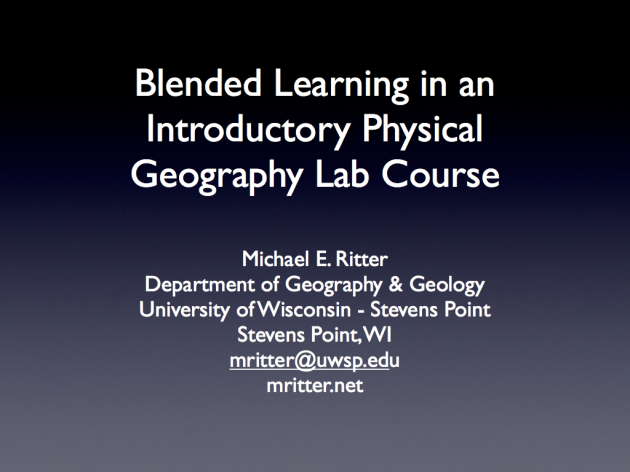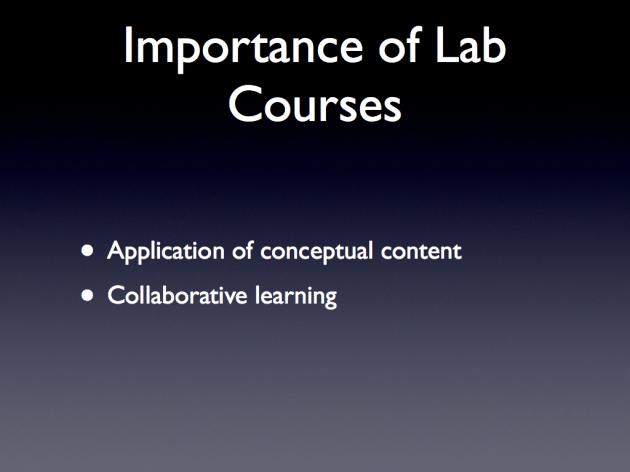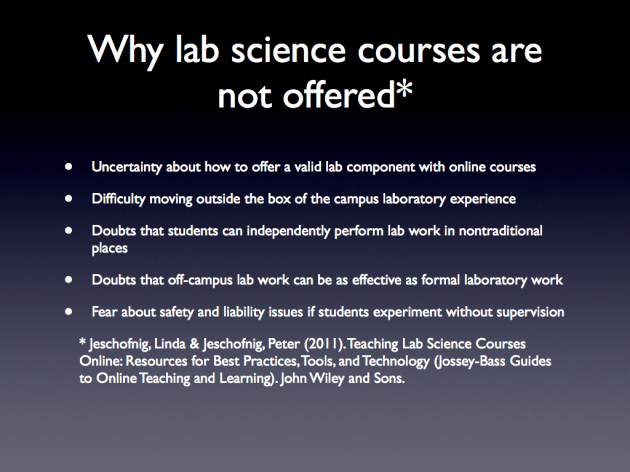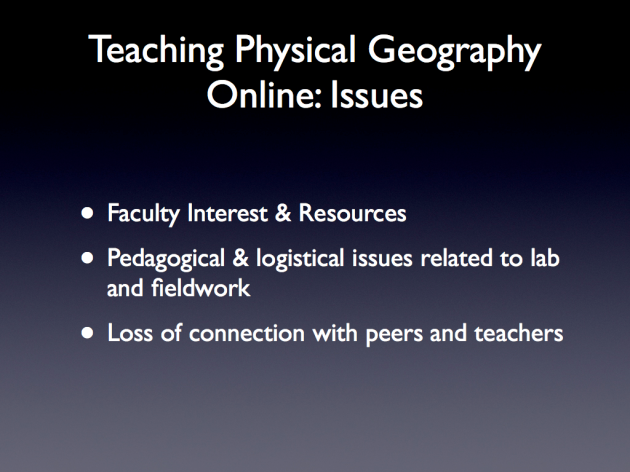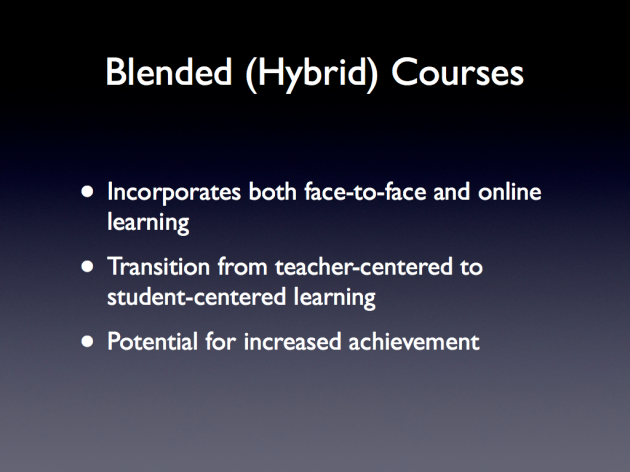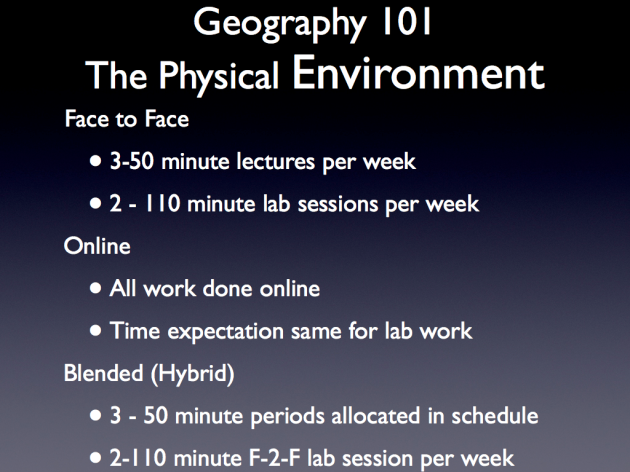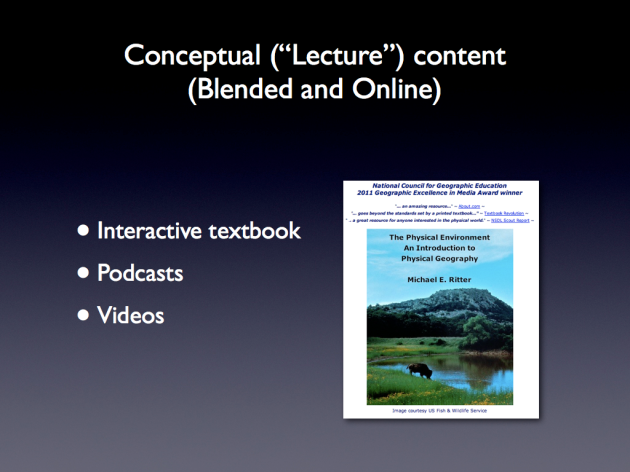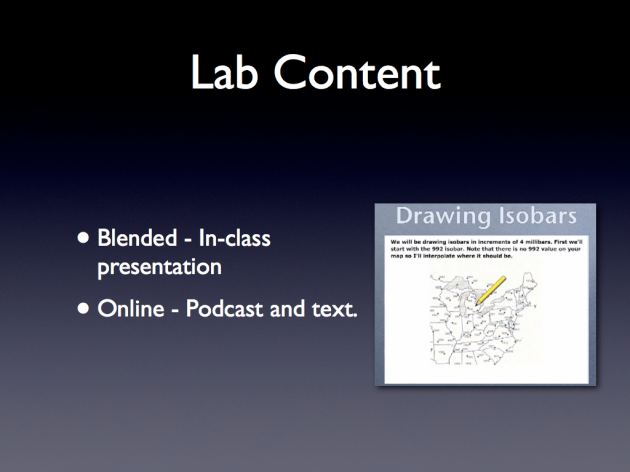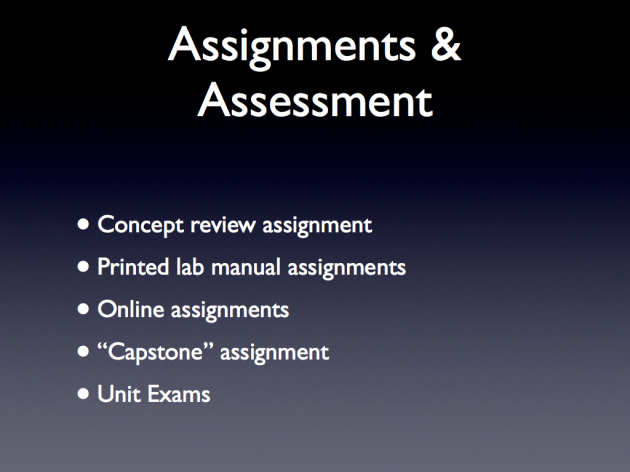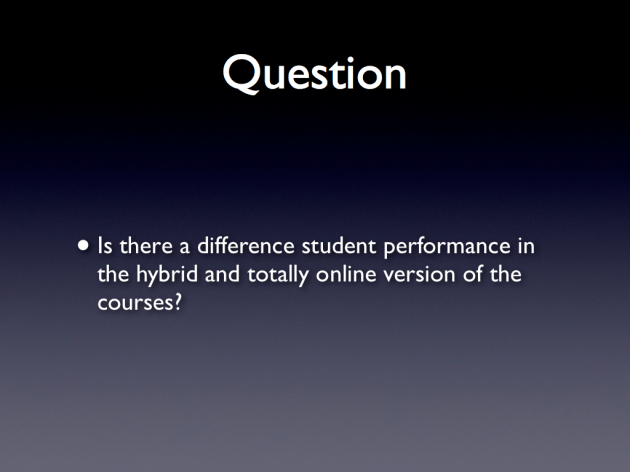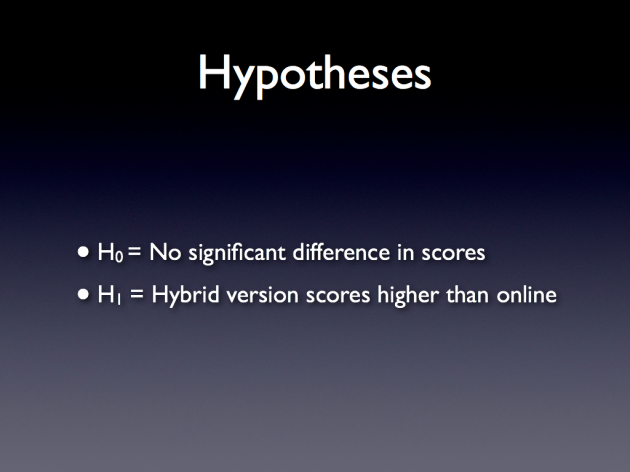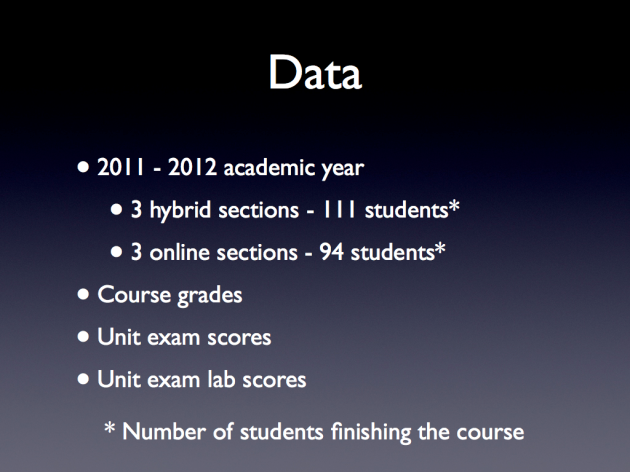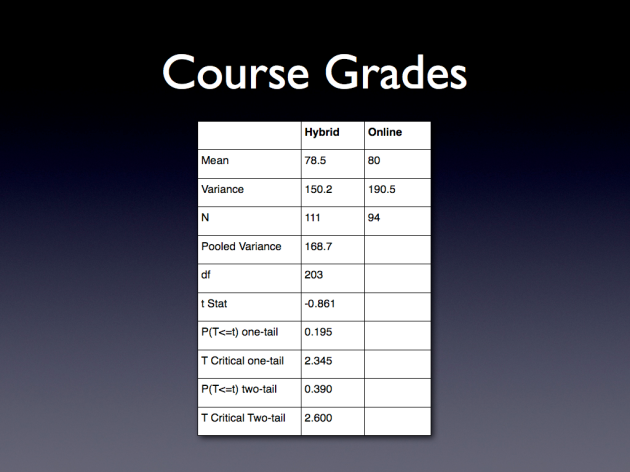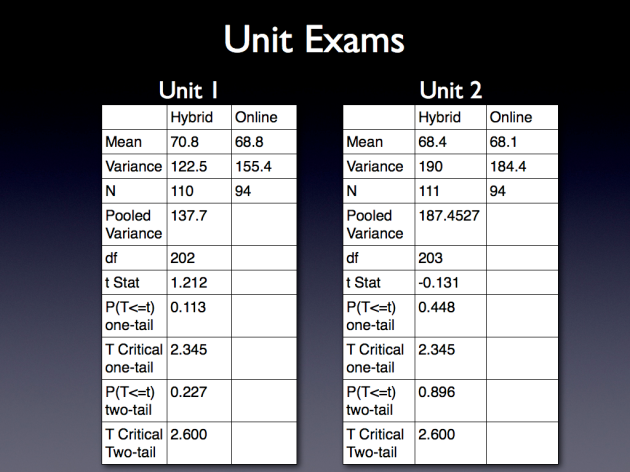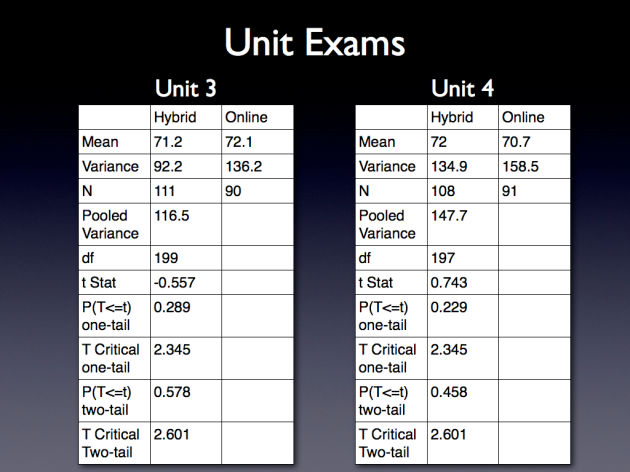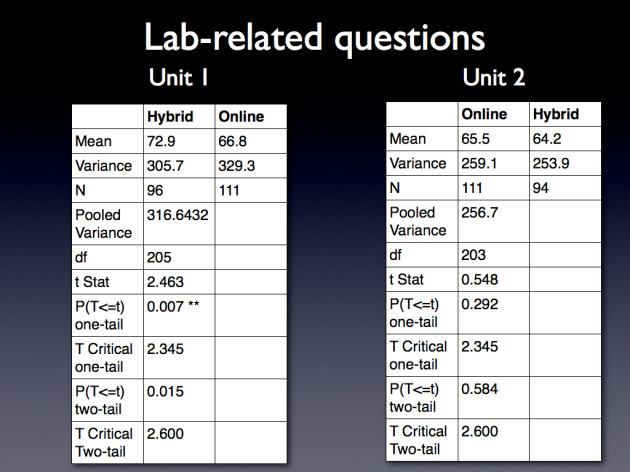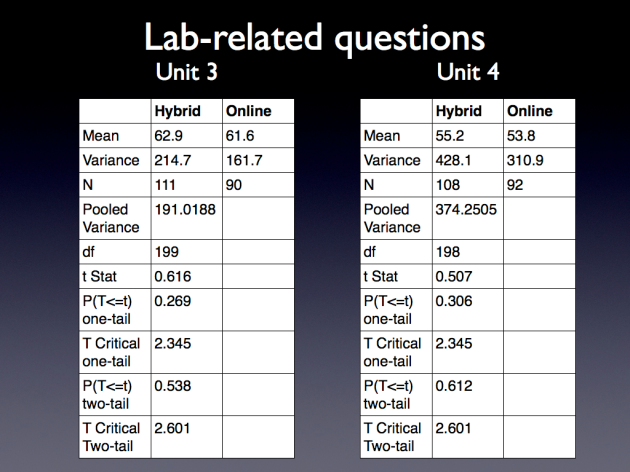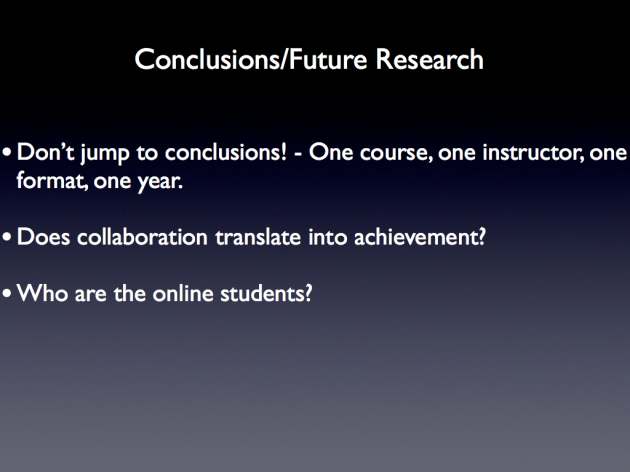Blended Learning in an Introductory Physical Geography Course
February 10, 2013 2 Comments
The following was presented at the 2012 annual conference of the National Council for Geographic Education.
Today I’d like to discuss the development of a blended or hybrid introductory physical geography course. I also want to share a preliminary, comparative analysis of student achievement in the hybrid and totally online versions of the course.
Those of us who teach laboratory courses know that they play an important role in science education. In the laboratory students apply the conceptual content of a course. It is also an opportunity for students to socially engage in a less formal, applied, collaborative way to promote learning.
Compared to other types of courses, lab science course have been slower to move online. Jeschofnig & Jeschofnig (2011) found several reasons for why lab science courses are not offered online:
- Uncertainty about how to offer a valid lab component with online courses
- Difficulty moving outside the box of the campus laboratory experience
- Doubts that students can independently perform lab work in nontraditional places
- Doubts that off-campus lab work can be as effective as formal laboratory work
- Fear about safety and liability issues if students experiment without supervision
Like other disciplines, e-learning in geography is gaining broader acceptance in higher education but not without concern over losing the soul of the discipline , especially its deep connection with places as AAG past president Gober (1998) warned us over a decade ago. A survey of geography departments that I recently conducted echoed the concerns presented by Jeschofnig & Jeschofnig. After faculty resources and interest, pedagogical and logistical issues were reasons for not offering totally online introductory physical geography courses (Ritter, 2012). Several survey respondents raised concerns over losing the face-to-face contact and social learning that takes place especially in the lab or field..
Others recognize the need to implement e-learning in geography education to address the special needs of nontraditional learners, employers and the ability to employ rich multimedia and active learning strategies (Lynch et. al, 2008, Glasmeier, 2012). One approach to address these issues is to blend online and face-to-face instruction.
Blended courses address the desire for face-to-face instruction while retaining many of the advantages of online learning. A blended or hybrid course delivers part of the content in a face-to-face setting and a portion online. The relative proportions of time devoted to online or in-person activities varies widely across blended courses and instructors. Blended learning lets the instructor reallocate class time for other purposes. Bended course enables the transition from teaching centered learning to student centered learning, or learner centered teaching. Students can be assigned pre-recorded lectures rather than passively sitting through a lecture, and then meet face-to-face to discuss and actively engage in the course content.
Those teaching blended courses make the assumption that students derive benefits from face-to-face interaction with their peers and instructors while taking more control over their learning in an online environment (Osguthorpe and Graham, 2003). Blended courses also cater to a range of learning styles (Mitchell and Forer, 2010). The 2012 ECAR survey of students showed that seventy percent said they learn more from blended courses Dahlstrom (2012).
At UW-Stevens Point we offer a traditional introductory physical geography course. Students meet three days a week for lecture and twice a week for a 110 minute lab.
In my conventional face-to-face sections I’ve offered an online component, the biosphere unit, since 1997. Surveys of students showed a desire for a totally online version, but most preferred a conventional approach.
I’ve offered a fully online version of the course since 2003 during the summer and as a part of my regular academic year course load since 2008.
In order to provide more flexibility to students, especially non-traditional students who wanted some face to face seat time, a blended (hybrid) version was created. Three 50 minute periods are allocated in their schedule but we do not meet face to face for the lecture. Lecture content is delivered through a custom online textbook, videos and podcasts. The students do meet for a conventional, 110 minute lab twice a week. A short introduction to the lab is given and then students work in groups of 4 students. Each student is responsible for submitting their own lab assignment.
Conceptual content delivered in a typical lecture has been moved to an interactive, multimedia physical geography textbook I’ve authored. Podcasts and videos are assigned to bring additional context to the textbook material and appeal to visual and auditory learners.
Lab content is delivered in-class in the blended section of the course. The first twenty to thirty minutes are used to relate the exercise of the day to the course content students have been studying online.Students break into groups of two to four students to complete an activity in a conventional printed lab manual.
Introductory remarks for the online section are communicated through podcasts and text material. It is assumed that the online students are working independently of one another.
Concept review assignments are 10 to 15 short answer questions that relate to the content of a course topic. These are graded as complete or incomplete. They are class participation credit so to speak.
Lab exercises from a printed commercial manual written by instructors at UWSP are also assigned. These too are graded as complete or incomplete.
Online assignments – students gather data from the web or use digital technologies like Google Earth to explore physical geography
Capstone assignment – Physical Regions of Wisconsin – students gather data for their home region and compare to another of there choosing. Explain similarities or differences based on their knowledge of physical geography.
Unit Exams – 75 questions, 50 conceptual, 25 lab. Timed, grouped by content with both the questions and answers randomized.
After running the hybrid course for two years I was curious to know if there were any differences in the achievement levels of those enrolled in these two types of courses. Based on the literature I expected that students in the hybrid might be achieving at at higher level. I’m also curious to see if there are particular concepts or lab activities that students in the online version might have more difficulty with and require additional help that the hybrid students have access to.
Based on the current literature, I expected the hybrid course to better than the totally online version of the course. My null hypothesis is that there will be no difference, and alternative hypothesis that the hybrid section will achieve higher scores.
The data for this analysis was gathered during the 2011-2012 academic year from 111 students in 3 sections of the hybrid course and 94 students of 3 sections from the totally online course. Course, unit exam, and unit exam lab scores were used in this analysis. For each version of the course I examined the achievement on four unit exams and the performance on the lab portion in for both online and hybrid versions of the c course were compared in this analysis. The course grade data includes performance on assignments and exams. Because of the way assignments are graded, exam scores are likely to tell us more about student achievement. The combined course data indicates there is no statistical difference between online and hybrid. The implication is that students can succeed in the course in a totally online learning environment.
A comparison of means for the course grades during the 2011 – 2012 academic year using a Student’s T-test showed no difference at the .01 level of significance. Thus, overall student performance in the course does not favor one learning environment over the other. Running the T-Test at the .05 level yielded the same result of no difference in means.
The overall course grades include to the scores attributed to the concept reviews for which students simply need to turn in reasonable responses to questions even though not quite correct. To get a better idea of student learning, performance on unit exams was compared. Again, a comparison of means test showed not significant difference between online and blended learning.
To tease out the effect of hybrid versus online learning in a lab setting, the performance on the lab portion of exams was compared. This filters out the influence of conceptual content from the applied content delivered via the lab assignment. In all cases, there was no significant difference in the mean scores of the hybrid and totally online versions of the course. Even so, the hybrid version was six percentage points higher on the first exam, with the difference between versions of the course substantially narrowing for the remainder.
This study focused on student performance in a lab section of a hybrid and online course. The results of this analysis imply that students can achieve equally well in a hybrid or online version of the course in this study. It calls into question whether the collaborative learning of the face-to-face lab session has any effect on student performance if similar instructional support is given to those in an asynchronous online laboratory version of the course. Online students access to some instructional materials is more flexible than those in the hybrid section, especially for the lab portion of the course. Online students have the advantage of replaying the instructional videos that explain lab procedures. Students in the hybrid section have only the one time explanation during class. What impact this has on difficult topics can be teased out through a more detailed analysis of exam results and a survey of student use.
Studies show those who do best in totally online courses tend to be self-motivated and independent learners (Abrahamson, 1998).It has been assumed that those students in the online section of the course worked independently. Schutte (1996) found online students scored higher on tests than their face to face counterparts. He attributed the performance differences to enhanced opportunity for online collaboration. A survey of students in the online course investigated here would check the validity of this assumption and provide additional insight into this and what characteristics influence student achievement in online and hybrid courses.
References:
Abrahamson, C. E. (1998). Issues in interactive communication in distance education. College Student Journal, 32(1), 33 – 43.
Dahlstrom, Eden, with a foreword by Charles Dziuban and J.D. Walker. (2012) ECAR Study of Undergraduate Students and Information Technology, 2012 (Research Report). Louisville, CO: EDUCAUSE Center for Applied Research, available from http://www.educause.edu/ecar.
Gokhale, A 1995 Collaborative Learning Enhances Critical Thinking Journal of Technology Education. Volume 7, Number 1http://scholar.lib.vt.edu/ejournals/JTE/v7n1/gokhale.jte-v7n1.html
Gober, P. (1998). Distance learning and geography’s soul. AAG Newsletter, 33 (5), 1-2.
Hofstein, A. and V. N. Lunetta (1982) The Role of the Laboratory in Science Teaching: Neglected Aspects of Research. Review of Educational Research Summer, 1982, Vol. 52 (2), 201-217
Hofstein, A. and V. N. Lunetta (2003) The Laboratory in Science Education: Foundations for the Twenty-First Century. Science Education. Volume 88 (1), 28-54
Illinois Online Network (ION). Weakness of online learning. http://www.ion.illinois.edu/resources/tutorials/overview/weaknesses.asp. Visited 6/10/2011
Jeschofnig, Linda; Jeschofnig, Peter (2011). Teaching Lab Science Courses Online: Resources for Best Practices, Tools, and Technology (Jossey-Bass Guides to Online Teaching and Learning) (Kindle Locations 330-333). John Wiley and Sons. Kindle Edition.
Means, B., Toyama, Y., Murphy, R., Bakia, M., Jone, K. Evaluation of Evidence-Based Practices in Online Learning: A Meta-Analysis and Review of Online Learning Studies, Washington, D.C., 2010. http://www2.ed.gov/rschstat/eval/tech/evidence-based-practices/finalreport.pdf
Mitchell, P. & Forer, P. (2010) Blended learning: The perceptions of first-year geography students. Journal of Geography in Higher Education, 34(1), pp. 77–89.
Osguthorpe, Phillipa and Pip Graham (2003) Blended Learning: Perceptions of First-year Geography Students. Journal of Geography in Higher Education. 34 (1) pp. 77-89
Osguthorpe, Russell T. and Charles R. Graham (2003) Blended Learning Environments: Definitions and Directions. The Quarterly Review of Distance Education. Volume 4(3) pp. 227-233
Ritter, M. (2012) Barriers to teaching introductory physical geography online. Review of International Geography Education Online. 2(1) pp. 61-77.
Schutte, J. G. (1996). Virtual teaching in higher education: The new intellectual superhighway or just another traffic jam? [Online]. Retrieved June 11, 1998 from the World Wide Web: http://www.csun.edu/sociology/virexp.htm.
Vavala, Robert V., Deana Namuth-Covert, Courtney Haines, Donald J. Lee, James W. King, and Carol Speth (2010) Community in Three Undergraduate University Science Courses: An Analysis of Student Perception. Journal of Natural Resources & Life Sciences Education • Volume 39, 157 -164
